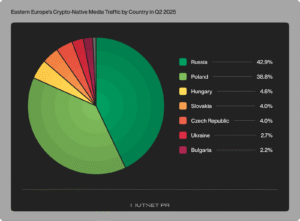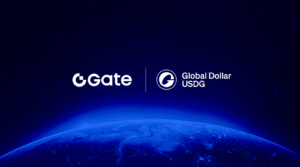Generative AI is quietly reshaping how crypto news travels in Eastern Europe, and the shift is happening faster than many expected. In its latest Q2 2025 report, Outset PR finds that AI platforms like ChatGPT are already driving measurable traffic to both crypto-native and generalist outlets with dedicated crypto coverage.
The report is the third in a year-long series of regional media studies, following Q1’s Latin America analysis and Western Europe’s MiCA-era breakdown.
Across Eastern Europe, one trend is clear: AI is emerging as a new front door for news discovery, even as the scale of referrals remains small for now. Crypto-native outlets recorded a total of 20.89 million visits, with AI referrals accounting for 135,180 (0.65%) of those visits. Generalist outlets had 894.48 million total visits, with 566,596 (0.06%) coming from AI tools.

Outset PR’s Q2 2025 report: How GenAI platforms are contributing to crypto-native and generalist media in Eastern Europe
At first glance, AI can be classified as a rounding error in a media site’s referral logs. Even so, those fractions still represent tens of thousands of readers, and the share is likely to grow as assistants become a more common entry point, especially in a market where a handful of countries and outlets dominate overall traffic. Outset PR’s survey adds color: editors reported fewer click-throughs when AI presents instant answers, occasional short-lived spikes when articles are cited by AI tools, and described GenAI traffic as “not yet reliable.”
In parallel, overall media visibility was under pressure: around 63% of both crypto-native and generalist outlets lost traffic, underscoring that GenAI is rising inside a broader discovery shake-up.
A Gatekeeper in a Concentrated Market
Unlike search engines or social platforms, generative AI returns inline summaries drawn from sources it deems reputable. Analysts warn that this departure from the search model that has been the primary option for over 20 years could push smaller publishers out of the competition.
Industry-wide, analysts are observing the same phenomenon: “Readers are increasingly getting headlines and answers directly from AI summaries or chatbots, cutting publishers out of the equation,” a recent analysis noted.
Russia and Poland dominate Eastern Europe’s crypto news market. The two countries generate about 80% of all Q2 visits, according to Outset PR. Specifically, Russia reached 8.44M visits (42.89%) and Poland 7.63M (38.76%) among crypto-native outlets; generalist traffic showed a similar tilt with Russia at 49.89% and Poland at 25.38%.
Add Romania, Belarus, and Ukraine, and you’ll see how just five countries together make up roughly 95% of the region’s total viewership.
The publisher breakdown reflects the same imbalance: 17 leading sites attracted more than 80% of regional readership, while dozens of niche outlets in the “long tail” barely registered.

Outset PR’s Q2 2025 report: Crypto-native media traffic in Eastern Europe is dominated by Russia and Poland
Western Europe showed the same pattern, with 13 major publications drawing 78% of the region’s audience, according to the aforementioned Outset PR’s report.
“People trust AI for quick answers – but when they’re investing $10,000, they still want a real source,” one survey respondent observed, suggesting that established brands may benefit from AI-era trust dynamics.
GenAI Referrals: Risk or Opportunity?
Generative AI’s impact so far is inconsistent. On one hand, the overall traffic contribution is very small, and direct traffic still dominates Eastern European crypto media by a large margin. In Q2, direct visits (that is, visiting a bookmark or typing in a website’s URL) accounted for 45% of crypto-site traffic. The obvious takeaway here is that loyal readers seek out trusted outlets and don’t use search engines.
Organic search trailed slightly at 42%, indicating that Google and other engines are almost as important as brand loyalty. On the other hand, referrals from third parties like news aggregators, forums, and AI platforms accounted for 6.6% of traffic, while social media links came in at around 5%.
Paid traffic accunted for just 0.06% for crypto-native outlets, and a similar 0.06% for generalist media.
Even in the general news segment, search and direct traffic together delivered about 79% of audience reach. Within social for crypto-native outlets, YouTube drove the largest share (16.16% of social traffic), followed by X (6.13%), Facebook (5.29%), and WhatsApp (3.68%). Outset PR also cautions that referrals from private/encrypted apps (e.g., Telegram/WhatsApp) may be undercounted and often appear as “direct.
For publishers, GenAI’s early gains signal a redistribution of discovery. More answers are delivered inline by chatbots, so it is important to be the sources those answers cite
“Google’s AI ‘Overview’ feature made zero-click news queries the norm for over two-thirds of users,” a separate study noted, as even top-ranked stories now often see no click-through.
ChatGPT’s news referrals surged 25 times globally between early 2024 and mid-2025, but industry data shows the boost falls well short of replacing lost search traffic.
Top Eastern European publishers could benefit from AI-driven traffic, but only if they establish themselves as go-to sources for chatbots. Because generative AI favors well-structured, high-quality content, some outlets are revamping SEO and metadata to increase the odds their work appears in AI responses.
Studies show AI-referred visitors leave sites sooner and click through fewer pages compared to those who arrive at a site from a search engine. Visitors arriving via AI tools tend to read the highlighted answer or snippet
“AI traffic isn’t clearly better; it’s different,” as an Ahrefs study put it, noting higher bounce rates despite slightly longer time-on-page. Without repeat visits, AI-sourced traffic offers little to no long-term benefit to smaller newsrooms. The ability to keep audiences engaged past the first answer still depends on offering substantive, high-quality coverage.
Adapting to the AI Discovery Era
Generative AI in search is helping publishers reach more readers. But it is also straining the revenue models that support journalism. In Eastern Europe’s crypto sector, the shift is playing out during an “uneven yet revealing” quarter, according to Outset PR, with regulatory and market forces in play. Q2 was uneven, with many outlets reporting mixed results amid changing discovery patterns.
Across the board, experts appear to point to one takeaway: adapting early gives publishers the best shot at winning the long game.
“Those who adapt to the AI landscape… may capture some of this emerging traffic stream,” noted one analysis of publishers’ response to chatbot referrals. Eastern European crypto newsrooms looking to adapt might start by making their stories more AI-friendly: clear headlines, tight summaries, consistent entity naming, and structured markup that machines can parse.
It also means doubling down on what makes an outlet an integral part of the conversation, such as exclusive interviews, breaking news, local insights, and investigative pieces.
Some are exploring partnerships or feeds that integrate their content into AI tools directly. This way, credit and traffic can be properly attributed.
Eastern Europe’s crypto media may be at a crossroads. Generative AI can reinforce a winner-takes-all dynamic, rewarding the most prominent voices and leaving little room for others. But it could also level certain playing fields, as users ask broad questions that might surface an insightful piece from a smaller Romanian or Slovak outlet if the AI deems it the best answer.
For now, the data shows AI-driven referrals are incremental, not existential: they’re a new layer on top of an already shifting landscape. Indicators suggest this layer will continue to grow. As AI becomes a front door to information, Eastern Europe’s crypto publishers who optimize for these new discovery methods stand to define the next wave of growth, while those stuck in old traffic paradigms risk falling further behind.
The race is on to engage not just the algorithms of Google and Facebook, but also the generative algorithms that may well guide the next generation of crypto readers
I’m a professional writer specializing in the field of cryptocurrencies. My work has been published in numerous online and offline publications which has made me one of the leading authorities in this industry. In addition to my work as an author, I’m also a highly sought-after speaker on the topic of cryptocurrency investing. I have given talks at some of the world’s most prestigious financial institutions, and my advice is regularly featured in the media.



